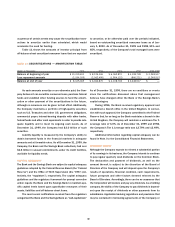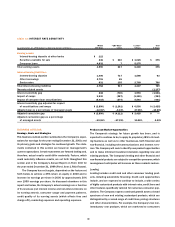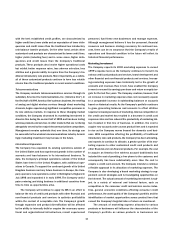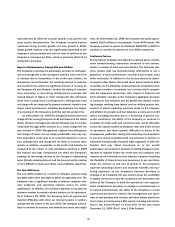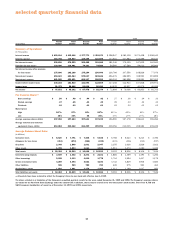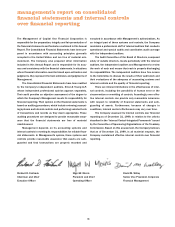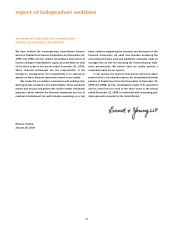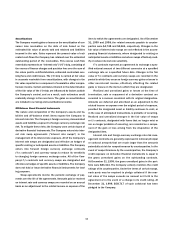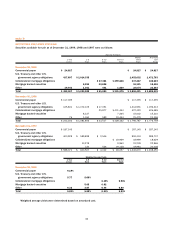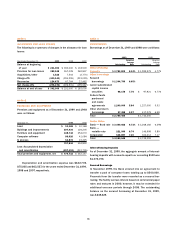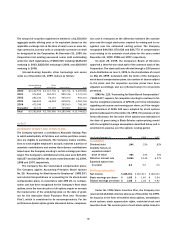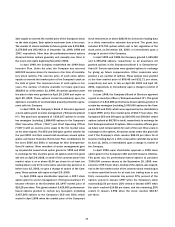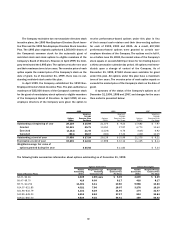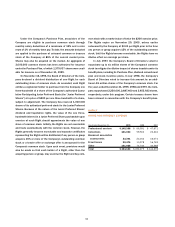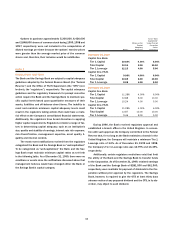Capital One 1999 Annual Report Download - page 51
Download and view the complete annual report
Please find page 51 of the 1999 Capital One annual report below. You can navigate through the pages in the report by either clicking on the pages listed below, or by using the keyword search tool below to find specific information within the annual report.
53
Securitizations
The Company records gains or losses on the securitization of con-
sumer loan receivables on the date of sale based on the
estimated fair value of assets sold and retained and liabilities
incurred in the sale. Gains represent the present value of esti-
mated cash flows the Company has retained over the estimated
outstanding period of the receivables. This excess cash flow
essentially represents an “interest only”(“I/O”) strip, consisting of
the excess of finance charges and past-due fees over the sum of
the return paid to certificateholders, estimated contractual serv-
icing fees and credit losses. The I/O strip is carried at fair value
in accounts receivable from securitizations, with changes in the
fair value reported as a component of cumulative other compre-
hensive income. Certain estimates inherent in the determination
of the fair value of the I/O strip are influenced by factors outside
the Company’s control, and as a result, such estimates could
materially change in the near term. The gains on securitizations
are included in servicing and securitizations income.
Off-Balance Sheet Financial Instruments
The nature and composition of the Company’s assets and lia-
bilities and off-balance sheet items expose the Company to
interest rate risk. The Company’s foreign currency denominated
assets and liabilities expose it to foreign currency exchange rate
risk. To mitigate these risks, the Company uses certain types of
derivative financial instruments. The Company enters into inter-
est rate swap agreements (“interest rate swaps”) in the
management of its interest rate exposure. All of the Company’s
interest rate swaps are designated and effective as hedges of
specific existing or anticipated assets or liabilities. The Company
enters into forward foreign currency exchange contracts
(“f/x contracts”) and currency swaps to reduce its sensitivity
to changing foreign currency exchange rates. All of the Com-
pany’s f/x contracts and currency swaps are designated and
effective as hedges of specific assets or liabilities. The Company
does not hold or issue derivative financial instruments for trad-
ing purposes.
Swap agreements involve the periodic exchange of pay-
ments over the life of the agreements. Amounts paid or received
on interest rate and currency swaps are recorded on an accrual
basis as an adjustment to the related income or expense of the
item to which the agreements are designated. As of December
31, 1999 and 1998, the related amounts payable to counter-
parties were $4,748 and $2,463, respectively. Changes in the
fair value of interest rate swaps are not reflected in the accom-
panying financial statements, where designated to existing or
anticipated assets or liabilities and where swaps effectively mod-
ify or reduce interest rate sensitivity.
F/x contracts represent an agreement to exchange a spec-
ified notional amount of two different currencies at a specified
exchange rate on a specified future date. Changes in the fair
value of f/x contracts and currency swaps are recorded in the
period in which they occur as foreign currency gains or losses in
other non-interest income, effectively offsetting the related
gains or losses on the items to which they are designated.
Realized and unrealized gains or losses at the time of
termination, sale or repayment of a derivative contract are
recorded in a manner consistent with its original designation.
Amounts are deferred and amortized as an adjustment to the
related income or expense over the original period of exposure,
provided the designated asset or liability continues to exist, or
in the case of anticipated transactions, is probable of occurring.
Realized and unrealized changes in the fair value of swaps
or f/x contracts, designated with items that no longer exist or
are no longer probable of occurring, are recorded as a compo-
nent of the gain or loss arising from the disposition of the
designated item.
Interest rate and foreign currency exchange rate risk man-
agement contracts are generally expressed in notional principal
or contract amounts that are much larger than the amounts
potentially at risk for nonperformance by counterparties. In the
event of nonperformance by the counterparties, the Company’s
credit exposure on derivative financial instruments is equal to
the gross unrealized gains on the outstanding contracts.
At December 31, 1999, the gross unrealized gains in the port-
folio were $83,314. The Company actively monitors the credit
ratings of its counterparties. Under the terms of certain swaps,
each party may be required to pledge collateral if the mar-
ket value of the swaps exceeds an amount set forth in the
agreement or in the event of a change in its credit rating. At
December 31, 1999, $58,717 of such collateral has been
pledged to the Company.


